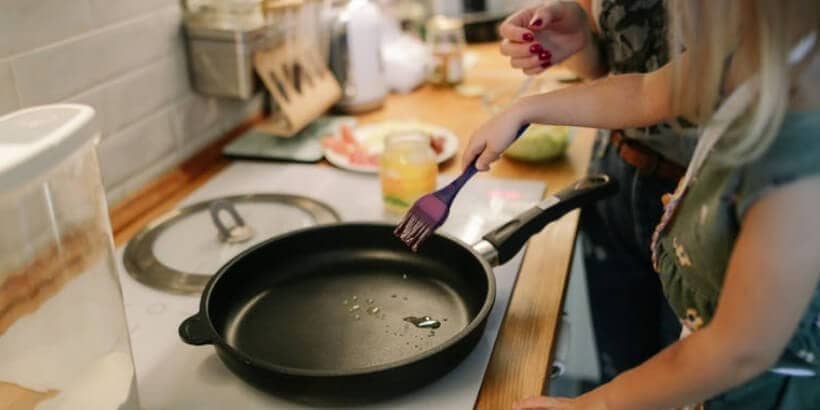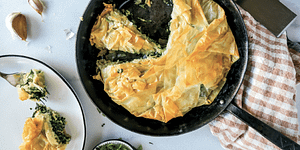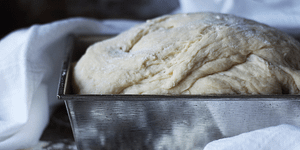How to Get Your Kids in the Kitchen

If you’re following a strict diet for health reasons, have picky eaters, or are simply looking for tips on how to get your kids involved in the cooking process, you’re going to want to settle in and read this. According to Leah Webb, author of The Grain-Free, Sugar-Free, Dairy-Free Cookbook, and the mother of two children with dietary restrictions, when children are included in the meal prep and cooking process, they become naturally curious and are more likely to actually eat the foods you are putting in front of them. But, she knows it’s easier said than done, so she’s offered up some tips and tricks to help you get your kids more involved in the kitchen!
The following is an excerpt from The Grain-Free, Sugar-Free, Dairy-Free Cookbook by Leah Webb. It has been adapted for the web.
Children are capable of far more than we sometimes give them credit for.
My son has been responsible for a variety of household tasks since he was three and a half years old. Now at age five, his tasks include things such as washing and putting away his own clothes, folding his sister’s cloth diapers and wipes, clearing the table after a meal, cleaning his room, brushing his teeth, carrying groceries, unloading the silverware from the dishwasher, taking out the compost, sweeping, vacuuming, and a variety of other self-care and household chores. Does he do these tasks willingly each time? Certainly not, but these chores are his responsibilities, he’s perfectly capable, and the completion of his duties provides him with a sense of independence, self-reliance, and a feeling of proud involvement. Children need to feel purposeful, and asking for their help with household tasks allows just that.
In the same way that I expect my children to participate in household chores, I expect them to participate in food preparation. My goal is to raise competent humans who are capable of cooking for themselves and their families someday. I also want to inspire their interest in food, and the best way to get kids interested in anything is to let them be involved.
I once managed a children’s learning garden, where a small group of four-through-eight-year-olds was responsible for planting and maintaining an organic vegetable garden. The kids enjoyed their work, but more importantly they loved eating the fruits of their labor! I remember having a small argument over who got to eat a handful of raw brussels sprouts, which certainly isn’t your everyday battle. The kids were interested in the food because they were involved.
While my kids are far from capable of cooking a meal from start to finish, they’re qualified to participate in smaller tasks during the food preparation process. I should note that it was not convenient to teach my children how to perform certain tasks. In fact, it made meal preparation much slower at first, but now that my son is more knowledgeable, capable, and efficient he’s actually quite helpful with certain tasks. Again, not all tasks; he’s just five.
For example, I let him cook scrambled eggs on occasion, but I have to hover over him like a hawk to make sure the eggs don’t burn. While it would be far easier for me to cook the eggs on my own, my thought is that this small investment of time will help him develop skills that enable him to contribute to the household in the future. How awesome will it be when I can ask my seven-year-old son to make us scrambled eggs and he can do it from start to finish? That’s the goal, and we’re on the path to accomplishing it.

One of the simplest yet most exciting things for my son to do in the kitchen is to operate appliances such as the food processor or blender. What can I say? Kids like buttons. I don’t allow him free reign with the appliances since he would likely turn my $400 blender off and on as quickly as his little fingers could muster, so I have to do a bit of monitoring.
My list of Jobs for Kids in the Kitchen (see below) is a basic introductory list and is by no means exhaustive. The best way to figure out how your child can help you in the kitchen is by observing yourself in the kitchen and making time to teach your child how to do your most basic tasks. As your children grow older you’ll be able to slowly entrust them with bigger tasks. I can’t wait for the day when I can assign dinners to my children and remove myself from the kitchen entirely. Will they fail at times? Of course. But I wouldn’t want it any other way.
I want them to be experimenting with foods and flavors so they can develop their own style of cooking. I certainly wouldn’t want to raise a child that’s afraid to try something new out of fear of missing the mark.
If you happen to have a small vegetable or herb garden, get your child involved. My two-year-old daughter is interested in helping with nearly every gardening task I perform, but the problem is that she’s not actually all that helpful. The trick is to give her a job that makes her feel as if she’s working alongside me, while not disrupting the actual work that has to be done. I give her a handful of the cheapest and biggest seeds I have (usually peas) and tell her to plant the peas. No additional instructions are provided. Random pea plants pop up all over the garden, but there are worse things in life.
My children are also given their own pots to plant when I’m planting my seed starts. I used to have my son help with the flats that we use in the garden each year, but this was extremely frustrating for both of us. Providing him with his own pots, soil, and inexpensive seeds was a much better solution for everyone. He has the freedom to work at his own pace and I have the freedom to get the job done the way that I like.
The last thing to remember is that kids aren’t actually all that helpful in the kitchen when they’re small or if they’re inexperienced. There are days, weeks, and even months that go by when I haven’t asked for my kids to help, not even once. I try to ask for their help on a semi-regular basis, but sometimes it’s a hard thing to do; I don’t always have the patience or time to deal with it. However, taking the time to teach your kids how to do even the simplest tasks in the kitchen will be hugely beneficial for the whole household. My son can now prepare the majority of the Plantain Muffin batter with minimal assistance. I still do the pouring, but it’s a task that I should probably let him do now that he’s older.
Dealing with a mess is part of having kids. Don’t let the mess deter you from teaching your child how to be a fully competent and functioning member of society. Your kids need experience in the kitchen in order to eat healthy for a lifetime. Don’t deprive them of this skill.
Jobs for Kids in the Kitchen
Cracking eggs
Whisking eggs
Cooking scrambled eggs in a pan (supervision may be required)
Stirring
Opening cans with a can opener
Scooping nut butters or dips onto a plate
Adding preportioned spices and salt
Measuring ingredients
Pouring measured ingredients into dishes or batters
Pouring batters into pans Sautéing vegetables (supervision may be required)
Washing fruits or vegetables
Chopping vegetables (supervision may be required)
Gathering vegetables from the garden
Mashing tuna for tuna salad
Serving their own food
Reheating foods on the stovetop, like soups (supervision may be required)
Plantain Muffins
Makes 24 muffins or two loaves of bread

Ingredients
1 cup (145 g) raw sunflower seeds
11⁄2 tablespoons cinnamon
2 teaspoon baking powder
1 teaspoon baking soda
1⁄2 teaspoon salt
4 ripe plantains, peeled and sliced into 2-inch pieces
4 eggs
1⁄2 cup (100 g) coconut oil
1⁄2 cup (120 ml) water
Directions
Preheat oven to 350°F (177°C).
Grind sunflower seeds into a flour using a high-powered blender or food processor. Do not overblend or the seeds will start to turn into a seed butter. If using a high-powered blender, 5–8 seconds of blending should be adequate, but it will take closer to 30 seconds in a food processor or less powerful blender. The flour will have the texture of almond flour. Scrape down the sides and corners after blending to free any lodged flour.
Add remaining ingredients to the blender or food processor in the order listed in the ingredients list and blend just long enough to form a smooth batter.
Pour batter evenly between 24 silicon muffin molds or paper-lined muffin pans, filling the cups about 3⁄4 full. The exact volume of batter depends on the size of the plantains. If you have excess batter, pour the remainder into additional muffin molds (if available) or into a greased bread pan for a long, at bread that can be cut into quarters or thirds depending on its size.
Bake the muffins for 25 minutes or until firm to the touch. If you have excess batter in a bread pan, this may take an additional 5–10 minutes to cook depending on its size.
Allow the muffins to cool for about 5 minutes before transferring them to a cooling rack.
For a delicious pecan bread variation, add 11⁄2 cups (170 g) chopped pecans and pour the batter into 2 greased bread pans. Bake the bread for 55 minutes or until completely set.
Batch Cooking and Leftovers: For batch cooking: Grind flour for both batches first. Then proceed in two batches (blenders are too small for a double batch.)
Freeze muffins for quick snacks or packed lunches.
Make It a Meal: Serve with Garlicky Greens and diced tomatoes, or fried eggs and Dill Pickle Kraut for a sweet and savory nutritious breakfast.
Recommended Reads
Recent Articles
Appetizers, meze, tapas . . . whatever the name, these small plates symbolize hospitality. Every culture has a unique collection of dishes to share. Here are our favorite savory bites to enjoy before a meal. Serve a few together for a vibrant lunch or dinner. In Chile, Clove, and Cardamom explore mouth-watering recipes from the…
Read MoreIf you’re ready to start growing a portion of your own food, but you aren’t quite ready for something that requires a big time commitment or a lot of effort, this is a good place to start. Sprouts are easy to cultivate, mature very quickly, can be used in a variety of delicious dishes, and…
Read MoreWant to spice up your traditional bread recipes? This salt-rising bread recipe by fermentation expert Sandor Ellix Katz has all the simplicity, flavor, and uniqueness you’ve been searching for! The following is an excerpt from Sandor Katz’s Fermentation Journeys by Sandor Ellix Katz. It has been adapted for the web. What Is Salt-Rising Bread? Salt-rising…
Read MoreLearning how to ask questions that will elicit relevant information is as much an art form as creating an herbal formula. Follow this broad list as a starting point.
Read MoreNothing says “spring” like a fresh, foraged meal! Savor the flavors of the season with this Milkweed Bud Pizza recipe.
Read More








